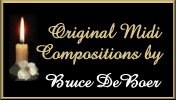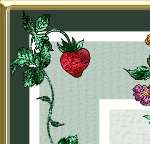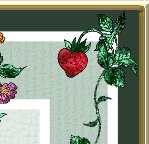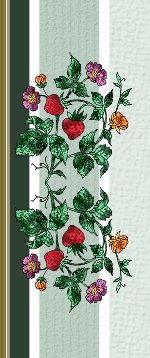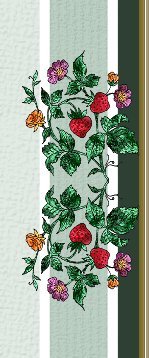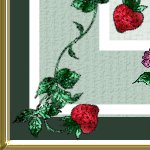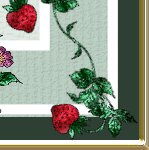The Human Earth
By the Rev. Lee Woofenden
For Earth Day and Arbor Day
Bridgewater, Massachusetts, April 26, 1998
Readings

Psalm 104:1, 14-24 The
Lord made the earth in wisdom
Praise the Lord, O my soul. O
Lord my God, you are very great; you are clothed with splendor and majesty. . .
.
You make grass grow for the
cattle, and plants for humans to cultivate, bringing forth food from the earth,
and wine to gladden the human heart, oil to make the face shine, and bread to
strengthen the human heart.
The trees of the Lord are
well watered, the cedars of Lebanon that he planted. There the birds make their
nests; the stork has its home in the pine trees.
The high mountains belong to
the wild goats; the crags are a refuge for the conies.
The moon marks off the
seasons, and the sun knows when to go down. You bring darkness, it becomes
night, and all the beasts of the forest prowl. The lions roar for their prey and
seek their food from God. The sun rises, and they steal away; they return and
lie down in their dens.
Then man goes out to his
work, to his labor until evening.
How many are your works, O
Lord! In wisdom you made them all; the earth is full of your creatures.

Revelation 5:11-14 Heaven
and earth praise the Lord
Then I looked and heard the
voice of many angels, numbering thousands upon thousands, and ten thousand times
ten thousand. They encircled the throne and the living creatures and the elders.
In a loud voice they sang: "Worthy is the Lamb, who was slain, to receive
power and wealth and wisdom and strength and honor and glory and praise!"
Then I heard every creature
in heaven and on earth and under the earth and on the sea, and all that is in
them, singing: "To him who sits on the throne and to the Lamb be praise and
honor and glory and power, for ever and ever!"
The four living creatures
said, "Amen," and the elders fell down and worshipped.

Heaven and Hell #106, 110 Correspondences
in nature
All the things that occur in
nature, from the smallest to the largest, are correspondences. This is because
the natural world and everything in it exists and endures from the spiritual
world, and both these worlds exist and endure from the divine. . . .
I would like to use a few
examples to show what the correspondence between spiritual and natural things is
like.
Land animals in general
correspond to emotions. The gentle and useful ones correspond to good emotions,
and the vicious and worthless ones correspond to bad emotions. To take some
specific cases, cows and calves correspond to the emotions of the worldly mind,
and lambs to emotions of the spiritual mind. The various winged creatures, on
the other hand, correspond to the intellectual parts of either mind.

Sermon
How many are your works, O
Lord! In wisdom you made them all; the earth is full of your creatures. (Psalm
104:24)
Continuing in my fine
tradition of observing special days just after they occur, today our
theme comes from Earth Day (which was Wednesday) and Arbor Day (which was
Friday). With spring bursting out all around us, it is hard not to think
about the wonders of the earth. Patty and I celebrated Arbor Day by going out
and buying a nice Sugar Maple, which we will be planting near the road in our
front yard. Our street is lined with beautiful maples, and the one we plant will
take the place of one that had to be taken down before we bought the house. And
so we will help to continue the cycle of nature, in which what is new and young
replaces what has grown old and died.
Some people would see a
contradiction in our tree planting. We plant a tree in an area where so many of
the trees have been cut down to make way for human houses. Can we really talk
about the cycle of nature where humans have so greatly disrupted that cycle? I
remember visiting one of my friends in the city some years ago; as I arrived, he
was busily hacking away at some runaway bushes that were spreading out from the
fence separating his lot from his neighbor's. There really wasn't much ground
for anything green to grow in, but that bush didn't care--it was obeying the
laws of nature, which say that where something can grow, it will
grow. He paused to say hello, and then laughed when I asked whether he had
finished beating back the wilderness. The joke is on us; no matter how much we
do beat back the wilderness, it simply will not stay down. The moment our
efforts cease--and even during our efforts--the wilderness is busily
creeping back into our islands of civilization.
We could view this as it has
been traditionally viewed: as a battle between humans and nature. We humans do
our best to carve out a corner in nature where we can live our lives in safety
from the often cruel and certainly thoughtless ways of nature, while nature
continually, implacably, reasserts itself wherever and whenever our efforts
slacken. We have all seen old roads, old parking lots, old tennis courts where
first grass and weeds, then bushes, then trees begin to reassert themselves from
the edges and from every crack in the pavement. Even our great cities and
suburban areas cover a relatively small proportion of the earth's surface--as
anyone who has traveled across the vast, largely undeveloped areas of our earth
can see and experience. Nature is still ascendant over humans throughout much of
our earth.
Yet we need not see it as a
battle. Certainly we humans do need to protect ourselves from the
elements. We are not equipped with sharp claws and long teeth to protect
ourselves using our bodies, as most of the larger animals are; but we are
equipped with intelligence that enables us to protect ourselves in more
sophisticated ways, with fences and walls and weapons. These days, though storms
and earthquakes do break through our defenses from time to time, for the most
part we are quite able to protect ourselves from nature. In fact, most people
are more afraid of what other people might do to them than they are of
what nature might do. In our times, after years of studying nature and learning
of its wonders, we are more inclined to feel that we will do better by
cooperating with nature as much as we can. Perhaps we can even learn something
from the balance of nature that will help us to restore our human society to a
balance we seem to have lost.
Whatever our relationship
with nature may be, one thing is certain: as long as we live on this earth, we
are inextricably linked with nature. Even city dwellers who spend most of their
lives surrounded by human-made objects are dependent on rural farms where their
food is grown. Our very civilization depends on energy sources that come from
nature. Oil is pumped up from the ground--and it got there through the
decomposition of trillions of tons of organic matter in ancient times.
Electricity is generated from oil or natural gas or water or wind power or some
other natural source of energy. Without the forces of nature, we could not run a
single internal combustion engine or turn on a single personal computer.
The more we realize this, the
more we understand that whenever we "defeat" nature, we are really
defeating ourselves as well. If and when we succeed in putting nature on the
run, we are putting ourselves on the run also, since we are destroying the basis
upon which everything we do in this material world is built. No matter how
removed from nature we may sometimes feel that we are, we humans, as physical
beings, are still an integral part of the web of nature, and we damage that web
to our own peril.
So far, I have not said
anything that could not be found in an ecologically oriented magazine or a
textbook in environmental biology. Though we certainly do continue to pollute
and damage our earth in dangerous and sometimes disastrous ways, our culture is
recognizing more and more that when we damage nature, we damage ourselves along
with it.
What we may be slower to
recognize as a culture is the source of this intricate web of life, and
why we human beings are so intimately tied in with the cycle of nature. Our
reading from Psalm 104 gives the most basic reason, in poetic language: It is
the Lord who created both us and the earth that we live in; and the Lord created
us to live together with this earth as long as we live in our physical bodies.
"How many are your works, O Lord! In wisdom you made them all; the earth is
full of your creatures." We are one of the creatures that the Lord has
made. "You make grass grow for the cattle, and plants for humans to
cultivate, bringing forth food from the earth." Yes, in God's plan, human
beings and the earth are bound together in a cycle of life.
We need not stop at physical
life in our search for the connection between human beings and the earth we live
in. We are dependent on the earth for our physical sustenance. But the
earth provides so much more, if our eyes are open to perceive it! Swedenborg
tells us, "All the things that occur in nature, from the smallest to the
largest, are correspondences. This is because the natural world and everything
in it exists and endures from the spiritual world, and both these worlds exist
and endure from the divine."
As with everything God does,
there are many levels of meaning and reality here. Things in nature correspond
to--or express the nature of--things in the spiritual world, which, in turn,
express the nature of God. This means we can travel up ladders of meaning from
the wonders of nature through the wonders of spirit to the wonders of God.
It also means that everything
in the created universe is unified and related to everything else in the
universe through that one central, creative being of God. Do we have anything in
common with a porcupine? Of course we do! We were both created by God, and we
each express something about God. Swedenborg's radical idea is that as we are
watching something in nature, spiritually we are watching the very same thing in
ourselves.
Have you ever seen a
porcupine waddle along, not too concerned about predators because it knows that
predators do not want a mouthful of quills? That porcupine is not only outside
of us, but within us as well. Each one of us is capable of making
ourselves so prickly that nobody will come near us. It is one of the ways we
protect our sensitive selves from people whom we feel may hurt us emotionally.
How about that tree Patty and
I will soon be planting in our front yard? Our own spirits also grow slowly,
gradually, from a tiny seed of spiritual longing and inspiration at first,
through stages of young and tender growth in understanding and effort toward
living in a more loving and spiritual way, through mature spirituality, firmly
rooted in the earth of practical, good living, with our branches reaching up to
the heavens from which the warmth and light of the Lord's love and wisdom shines
on us, giving us the energy to continue growing and reaching out toward others
in the fruitfulness of love and service.
The deeper message of our
earth is that as we look at the world of nature around us, we are also looking
at the human world of spirit within us. What we do to our earth goes far beyond
a cause and effect relationship in which the damage we do to our earth
boomerangs on us and damages us in turn, while the good things we do for our
earth rebound to us in richer harvests and healthier bodies. We have not only a physical
relationship with the earth, but a spiritual one as well. For the things
we do to the earth are simply another manifestation of the things that we do to
each other and to ourselves. If we are so intent on profit that we will pollute
and damage our earth to acquire it, this is simply another way of expressing the
damage we are willing to do to each other and to ourselves in pursuit of our own
advantage.
Similarly, if we care about
the world of nature around us, isn't it the same care that we have for each
other, and for all that God has created in the divine image? Our treatment of
nature is a signpost indicating our treatment of each other and of God. Nature
is a realm where we are at home because it reflects God's image, which is a human
image. As we realize this, we realize that our treatment of nature is the same
as our treatment of ourselves.
As we enjoy the beauties of
spring, may we join the universal chorus of praise that John describes in Revelation: "Then I heard every
creature in heaven and on earth and under the earth and on the sea, and all that
is in them, singing: "To him who sits on the throne and to the Lamb be
praise and honor and glory and power, for ever and ever!" Amen.
praise that John describes in Revelation: "Then I heard every
creature in heaven and on earth and under the earth and on the sea, and all that
is in them, singing: "To him who sits on the throne and to the Lamb be
praise and honor and glory and power, for ever and ever!" Amen.


Music: In the Garden
© Bruce DeBoer
